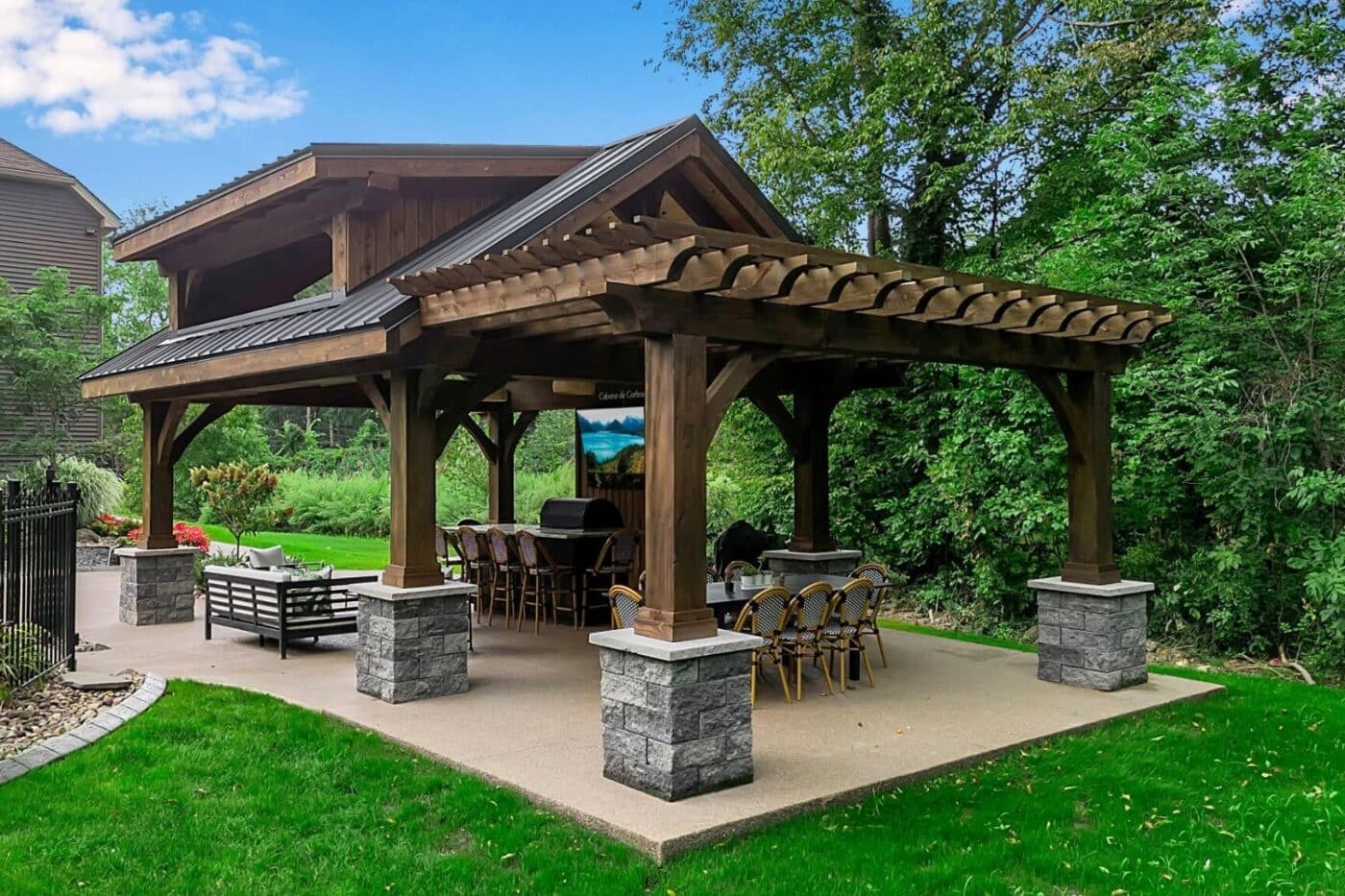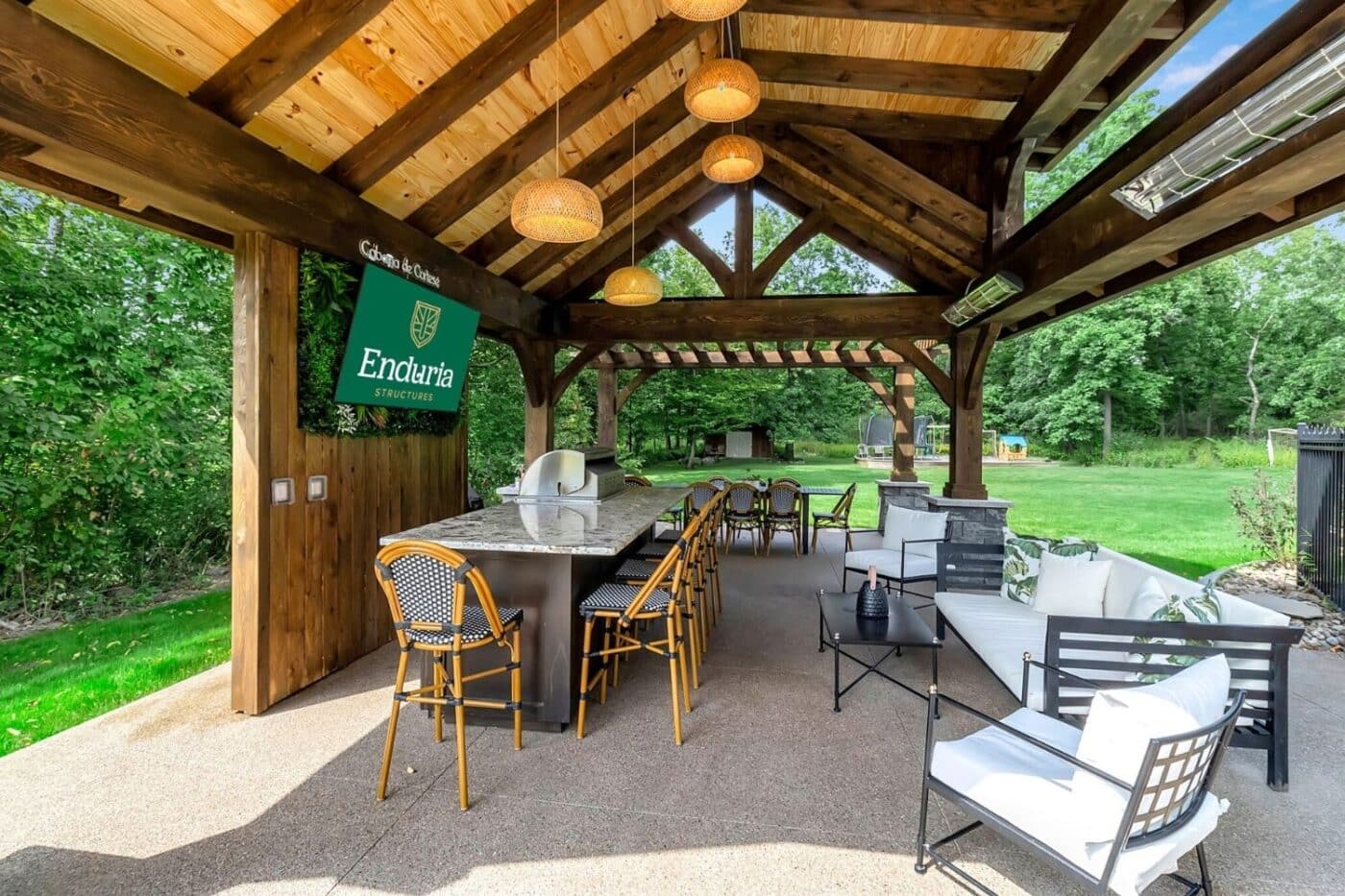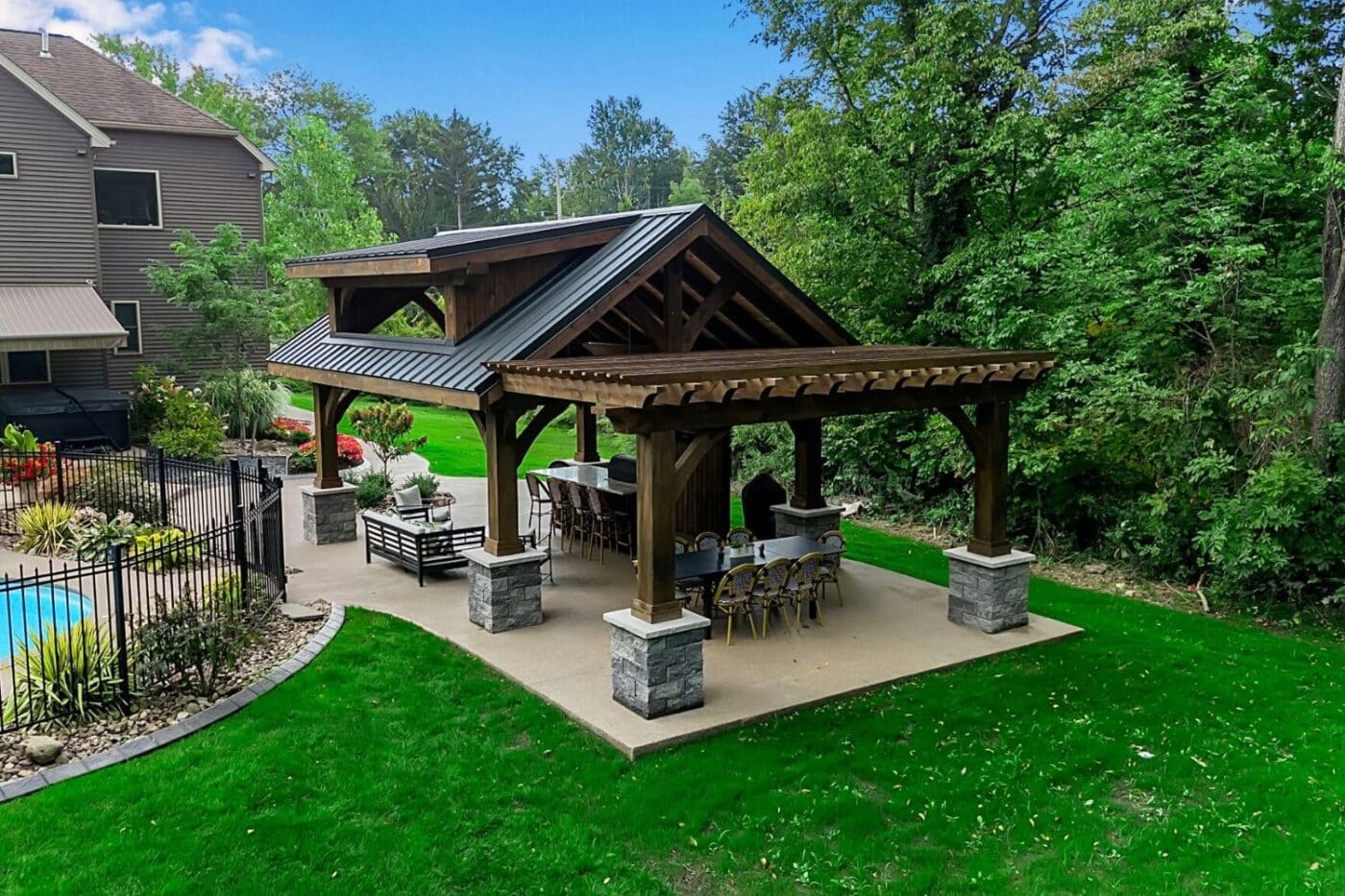
If you’re considering adding a pergola or pavilion to your yard in Pennsylvania, the first step is understanding whether you need a permit. The answer isn’t one-size-fits-all, permit requirements vary widely depending on your municipality, the size and location of the structure, and whether it’s attached to your home. Some towns allow small, freestanding structures without oversight, while others treat any new outdoor build as a structural addition requiring full review under the Pennsylvania Uniform Construction Code.
That means checking with your local zoning and building department early can save you from unexpected fines, delays, or the need to dismantle your project later.
When Is a Permit Required for a Pergola in Pennsylvania?
There’s no universal rule across Pennsylvania when it comes to permits for pergolas, but in general, the need for one often depends on the size and permanence of the structure. A small, decorative pergola set up on a patio may not need approval, but if you’re building something larger or anchored into the ground, it’s a different story.
A permit is typically required if you’re making structural changes to your property or if the pergola exceeds specific height or square footage limits. These thresholds vary depending on where you live. For example, some municipalities might allow you to build up to a certain size, say, 120 square feet, without a permit, while others might require documentation for anything over 50 square feet.
When Is a Permit Required for a Pavilion in Pennsylvania?
Under the Pennsylvania Uniform Construction Code (UCC), a building permit is required for most new construction, additions, or major structural changes in Pennsylvania. However, many municipalities implement exemptions for detached accessory structures, such as pavilions, which can mean no UCC building permit is needed, provided the structure meets specific criteria (for example, it is detached, under a specific size, and not intended for occupancy).
For a pavilion in Pennsylvania, a permit is normally required when the structure:
- Is attached to a primary dwelling or building,
- Exceeds local height or size limits,
- Includes utilities (electrical, plumbing) or habitable space,
- Falls under zoning conditions requiring setback, location, or use approval, even if a building permit might not be needed.
Since local municipalities may adopt amendments and rules beyond the state UCC, it’s essential to check both the building code and zoning regulations in the township or city where the property is located before proceeding.
Do you need a different permit for a pavilion than a pergola?
In most cases, pavilions and pergolas fall under the same general permit categories, meaning you’ll need similar zoning approval and, often, a building permit for either one. The exact requirements depend on the size, height, roof style, and local regulations of your structure.
Several key details can trigger permit requirements:
- Size and Height: A compact pergola may fly under the radar, but taller or wider structures usually prompt additional scrutiny. Taller pergolas can impact sightlines, neighboring properties, or even create runoff concerns, which is why they’re more tightly regulated.
- Attachment to a Home: If your pergola is physically connected to your house, it’s likely to be treated more like an addition than a stand-alone feature. Attached pergolas often require more paperwork and may need to follow stricter code compliance compared to freestanding versions.
- Purpose of the Structure: What you plan to use the pergola for matters. A decorative archway won’t raise many red flags, but if it’s designed to shelter a hot tub, grill, or outdoor kitchen, building officials may view it as part of a functional living space, and that often changes how it’s classified under code.
- Local Regulations: Perhaps the most important factor of all is where you’re located. Pennsylvania is a patchwork of zoning districts, each with its own ordinances. A rural township may give you more leeway, while a more densely populated borough might enforce stricter standards. Setback distances, lot coverage limits, and visibility concerns near roads or neighboring properties may also come into play.
In short, the rules aren’t just about how big the pergola is, they’re about how it interacts with your home, your neighbors, and your local community. That’s why checking with your township or zoning office before buying materials or digging holes is always the smartest move.
Building Permits By City in Pennsylvania
One of the most challenging aspects of building a pergola in Pennsylvania is navigating the patchwork of local codes that vary from one township to the next. What’s perfectly acceptable in one area might be restricted or even prohibited in another, so where you live makes a big difference.
| Allentown | Zoning Office |
| Altoona | Building Permit & Plan |
| Bethlehem | Forms & Permits |
| Butler | Applications & Permits |
| Chester | Licensing & Inspection |
| Easton | Forms & Documents |
| Erie | Permits |
| Harrisburg | Bureau of Codes |
| Hazleton | Permits & Lincenses |
| Johnstown | Permits |
| Lancaster | Building Permits |
| Lebanon | Building & Zoning |
| McKeesport | Building Permits |
| Philadelphia | Permits, Violations, & Licenses |
| Pittsburgh | Permits, Licenses, & Inspections |
| Reading | Permits, Applications, & Licenses |
| Scranton | Building Permits & Contractor Information |
| State College | Permits |
| Wilkes-Barre | Building Permits |
| Williamsport | Bureau of Codes |
| York | Bureau of Permits & Inspections |
Building Permits By County in Pennsylvania
Philadelphia
As a major city with a dense urban layout, permits are often required for nearly all outdoor structures, even smaller ones. Pergolas in Philadelphia typically fall under the same permit requirements as decks or covered patios, meaning you may need to submit detailed plans, obtain zoning clearance, and pass inspections before and after construction. The city’s building department also tends to be more thorough about fire codes, property line setbacks, and utility easements.
Pittsburgh
Pittsburgh operates under its own zoning code, which tends to be slightly more flexible depending on the neighborhood. That said, any structure that’s anchored to the ground or attached to a home will usually require a permit. In hillside districts, additional rules may apply regarding stability and drainage, which can impact where and how a pergola can be built.
Chester County or Montgomery County
In suburban areas like Chester County or Montgomery County, you may find a bit more breathing room, literally and legally. Some townships allow freestanding pergolas up to a certain square footage without a permit, as long as they remain a specified distance from property lines. Others may only require zoning approval if the structure doesn’t have a roof or solid sides.
Rural Regions
Meanwhile, in more rural regions such as parts of Lancaster County or Bradford County, permitting can be more relaxed. Many rural municipalities focus on agricultural land use and may not be as strict with backyard improvements, especially if your lot is large and far from neighbors. However, even in these areas, it’s not a guarantee. Some townships still require basic zoning forms, particularly if the pergola is larger or near a right-of-way.
Allegheny County
Which includes Pittsburgh and surrounding suburbs, is an excellent example of a region where zoning regulations can shift quickly from one borough to another. One township may require engineered drawings and multiple inspections, while the next may only need a sketch and a fee.
Because these rules are so localized, it’s essential to contact your township’s zoning or building department before you start planning. A five-minute phone call or a quick visit to your local office can save you from costly mistakes and ensure your project stays within legal bounds. Don’t rely solely on what a friend did in the next town over; the rules that apply to your property are often specific to your street, your lot size, and even your zoning designation.
Building Codes and Safety Requirements | Pergola Permit in Pennsylvania
Even though a pergola might seem like a simple backyard upgrade, it’s still a structure, and like any structure, it needs to meet specific safety and building standards. Pennsylvania municipalities often reference state-wide codes while adding their own requirements based on local geography, climate, and zoning plans.
Anchoring Pergola
One of the first things inspectors look for is how your pergola is anchored to the ground. If you’re installing a freestanding pergola, it usually needs secure footings that reach below the frost line to prevent shifting during seasonal changes. In many areas, that means digging at least 30 to 36 inches deep and using concrete piers or metal anchors designed for long-term stability. A lightweight pergola that isn’t anchored properly can become a hazard during high winds or even tip over in heavy snow.
Setback Regulations
Setback regulations are another common sticking point. Setbacks refer to the required distance between your structure and the property lines. These vary widely depending on whether your lot is residential, agricultural, or part of a planned community. For example, your pergola may need to be at least 5 to 15 feet from the side or rear property lines, and sometimes farther if it’s tall or attached to the house. These rules are in place to protect neighboring properties and to maintain emergency access.
Wind Load and Snow Load Compliance
Wind load and snow load compliance are critical in Pennsylvania, especially in regions that experience heavy winter storms. Pergolas must be able to withstand a certain amount of force from both wind and weight, something local building officials are increasingly concerned with as storms become more intense. Depending on your location, your design may need thicker posts, more cross-bracing, or a particular layout to ensure it meets these structural demands.
Fire Safety
Material choices also matter, especially when it comes to fire safety. If your pergola is going to be used near a fire pit, grill, or outdoor kitchen, local codes may require the use of flame-resistant materials or a minimum distance between the heat source and any wooden beams or roofing. In some areas, fire-retardant treatments or protective shields are recommended or even required. It’s not just about following the rules, it’s about keeping your family and property safe.
In short, what you build and how you build it is just as important as where you build it. Taking the time to understand these safety and structural guidelines at the outset will not only help you avoid headaches, it will also help ensure your pergola lasts for years and weathers all four seasons in Pennsylvania with ease.
HOA and Neighborhood Restrictions
Even if your local township doesn’t require a permit, your HOA might have its own set of rules. Homeowners Associations often regulate outdoor structures like pergolas to maintain neighborhood appearance and property values. These rules can cover everything from size, location, and height to color, roofing, and materials used. Some HOAs may not allow pergolas at all, or may require them to be positioned out of view from the street.
Violating HOA guidelines can result in fines, formal complaints, or forced removal of the structure. Before buying materials or hiring a contractor, review your HOA’s covenants, conditions, and restrictions (CC&Rs). Most associations also require an architectural review with sketches or site plans, and approval may take time, especially if board meetings are infrequent. In master-planned communities, restrictions tend to be more specific and may even dictate pergola style, trim, lighting, or surrounding landscaping.
Steps to Get a Pergola Permit in PA

If you’ve determined that your pergola project requires a permit, the next step is to understand what the permit process actually entails. While every municipality handles things a little differently, most follow a similar framework. Taking it one step at a time can help keep your project on track and avoid unnecessary delays.
1. Contact Your Local Zoning or Building Office
Start by reaching out to your township or borough’s zoning or building department. You can often find the contact info on your local government’s website. A quick phone call or in-person visit will help you determine exactly what kind of approval you need. Be ready to answer questions about the size, location, and purpose of your pergola. Some municipalities may only require zoning clearance, while others might expect complete building permit documentation.
2. Submit Drawings and Detailed Plans
Once you know what’s required, the next step is to gather your paperwork. This usually includes a sketch or professionally drawn plan that shows the layout of your pergola on your property. You’ll likely need to include measurements, materials, and distances from property lines or existing structures. If the pergola is to be attached to your home, additional documentation, such as structural calculations or load-bearing specifications, may be necessary. Double-check that your drawing clearly shows where the pergola will sit relative to utilities, easements, and neighboring properties.
3. Pay Any Required Permit Fees
After submitting your plans, you’ll be asked to pay a fee for processing the application. Permit costs can vary widely depending on your location and the scope of your project. In some rural townships, you might pay as little as $25 to $50. In more regulated areas or larger suburban counties, the fee might range from $100 to $300 or more, especially if engineering reviews are involved. Some areas may combine the zoning and building permits into one process, while others keep them separate.
4. Wait for Approval and Schedule Any Needed Inspections
Once your application is submitted, there may be a review period. This can range from a couple of days to a few weeks, depending on the project’s complexity and the department’s workload. If your plan meets local codes, you’ll receive your permit, usually in the form of a printed certificate or sticker that must be visible during construction. In some cases, an inspection may be required before and/or after the build. This ensures your structure was built according to the approved plan and meets safety standards.
It’s worth noting that some municipalities may also require notification to utility companies before you dig any footings, especially if electrical lines, water lines, or gas pipes run underground. Calling 811, the national “Call Before You Dig” number, is a simple way to avoid costly mistakes.
By following the steps carefully and checking all the boxes upfront, you can avoid hold-ups that could otherwise derail your project mid-way. Permitting may seem like a hassle at first, but it’s ultimately there to protect your investment and ensure your pergola remains sturdy for years to come.
What Happens If You Build Without a Permit?
It might seem harmless to build a small pergola without a permit, but doing so can lead to serious consequences. In many Pennsylvania municipalities, unpermitted construction is a code violation that can result in daily fines, forced removal, or expensive modifications, especially if the structure encroaches on setbacks or utilities.
Even applying for a permit after the fact doesn’t guarantee approval, particularly if the build doesn’t meet safety or zoning standards. Skipping permits can also affect your homeowners’ insurance. If damage occurs and the pergola wasn’t approved or inspected, your claim could be denied.
Unpermitted structures may also impact resale. Buyers, appraisers, and lenders often require proof that additions meet local codes. Delays, reduced offers, or required removal are all possible outcomes. In the end, cutting corners now can cost you more later. Taking the right steps protects your property and your peace of mind.
Permit-Free Pergola & Pavilion Options
In Pennsylvania, some pergolas and pavilions may not require permits, especially if they’re small, freestanding, and not permanently anchored. Many townships allow structures under 100–120 square feet and below 8–10 feet tall without formal approval, as long as they’re considered temporary or decorative.
Using lightweight, modular kits and avoiding deep footings or attachments to your home can also reduce permitting requirements. Freestanding pergolas placed a few feet from the house are more likely to be exempt than attached ones.
That said, every township has its own rules. Always check with your local code office to confirm size limits and exemption guidelines before building. Designing with these limits in mind can save time, money, and hassle.
Frequently Asked Questions
Do small pergolas or Pavilions need a permit in PA?
Small pergolas or pavilions in Pennsylvania may not need a permit if they’re under 120 square feet, freestanding, and meet local setback and height requirements. However, rules vary by township, so it’s important to check with your local zoning office before building.
Can I build a pergola or Pavilion on a deck?
Yes, you can build a pergola or pavilion on a deck, but it’s often considered a structural addition and may require a permit. You’ll also need to ensure the deck can support the added weight and meet local building code requirements.
What size pergola or Pavilion can I build without a permit?
In many Pennsylvania townships, you may not need a permit for a pergola or pavilion under 100 to 120 square feet if it’s freestanding and meets local requirements. However, factors like height, anchoring, and placement still apply, so it’s best to confirm with your local building office.
Do you need a permit to install a pergola or Pavilion in PA?
In Pennsylvania, you’ll usually need a permit to build a pergola or pavilion, but the exact rules depend on your local municipality. Many townships consider pergolas to be “accessory structures,” which often require approval if they’re over a certain size or connected to your house.
How far from property line can I build a pergola?
In Pennsylvania, there’s no universal setback distance for pergolas, the required space from the property line depends on your municipality’s zoning rules. Since pergolas are typically classified as accessory structures, they may be subject to permits and distance regulations if they’re above a certain size. To avoid issues, it’s best to consult your local zoning or building office for accurate guidelines based on your location.
Pergolas & Pavilions for Sale in PA

Ready to transform your outdoor space with timeless style and comfort? At Enduria Structures, we make it easy to bring your pergola or pavilion vision to life. Whether you’re designing a cozy backyard retreat or a stylish shade solution for your patio, our expertly crafted pergolas and pavilions are built to last and built to impress. With customizable options, premium materials, and a team that understands Pennsylvania’s permitting landscape, we’re here to help you every step of the way. Explore our selection of pergolas and pavilions for sale, and let’s create a space that’s as functional as it is beautiful.
